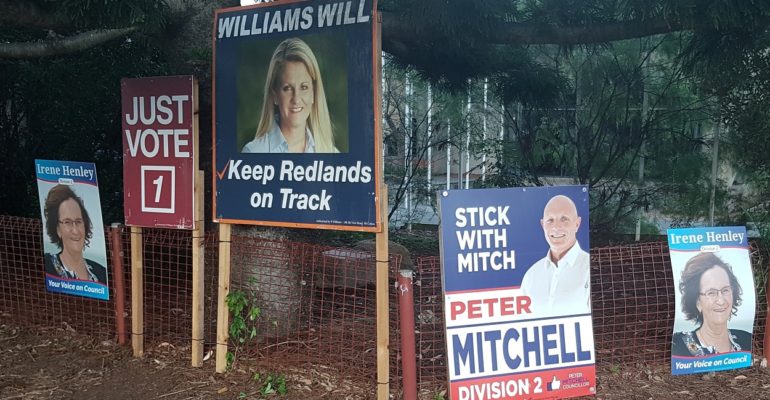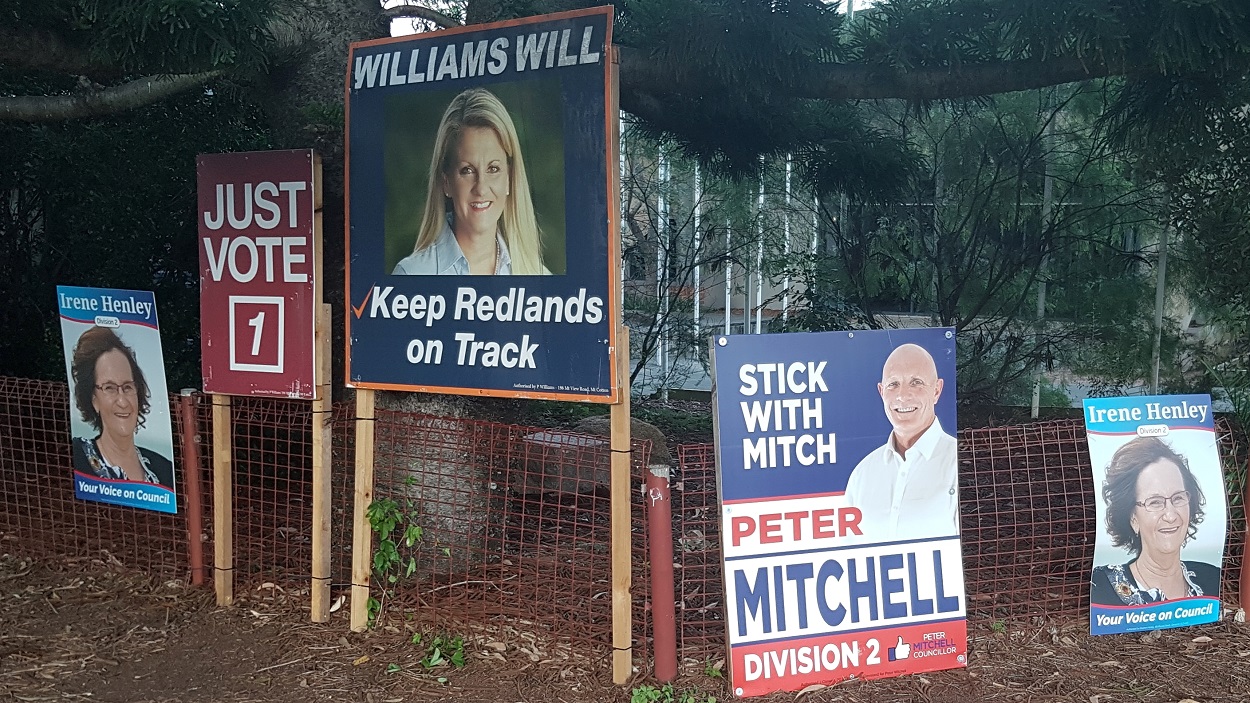

In an earlier comment on the Redland City election, I made the point that two factors would determine whether Richardson or Williams would be the eventual winner. These were
- What proportion of those who voted for Curtin voters allocated a preference
- What is the distribution of preferences (i.e. what proportion of those who voted for Curtin have voted 2 Richardson and what proportion have voted 2 Williams).
The final outcome
The final result from the Queensland Electoral Commission is:| Candidate | Count | Percentage |
| RICHARDSON, Claire | 38,241 | 49.11% |
| Declared: WILLIAMS, Karen | 39,634 | 50.89% |
| Preference Distribution | RICHARDSON, Claire | CURTIN, David Allan | WILLIAMS, Karen | Exhausted | Votes Remaining in Count | Total Formal Votes |
| First Preference | 35,037 | 12,428 | 38,488 | 85,953 | 85,953 | |
| CURTIN, David Allan excluded | 3,204 | 1,146 | 8,078 | 4,350 | 12,428 | |
| Total | 38,241 | 39,634 | 8,078 | 77,875 | 85,953 |
- 8,078 of the Curtin votes were exhausted as they had not stated any preferences.
- 35% of Curtin voters (4,350) indicated a preference.
- The exhaustion of the 8,078 votes that gave no preference meant in the second round of counting the majority was 50% + 1 of 77,875 and not 50% + 1 of the 85,953 formal votes cast.
- 74% of the 4,350 Curtin voters who gave a preference put Richardson at 2; these 3,204 votes are shown in the third row of the table . The 1,146 that went to Williams are also shown in this row.
- The low number of Curtin votes giving a preference is the major mathematical factor in explaining the outcome.
- With the same 74/26 split in preferences, Richardson would have been the winner if 58% of the Curtin votes had given a preference.
Preferential voting
The principle of preferential voting is that the winning candidate must get an absolute majority – that is at least 50% + 1 of all votes cast. This compares with ‘first past the post’ where the winner is the candidate with the most votes irrespective of the proportion of votes cast. It is possible to be elected with just a little over 25% of the vote in a first past the post system with four candidates. Multi-round, ‘run-off’ ballots are another way of requiring the winner of an election to get an absolute majority. They are used, for example, in Presidential elections in more than 40 countries including Austria, East Timor, France, Indonesia and Russia. They are also used by some political parties (including the LNP) for internal votes. If no candidate has an absolute majority on the first ballot, a further ballot or ballots are held. There are minor variations as to whether only a second ballot is held between the two candidates who gained the most votes or there is successive elimination of the candidate with the lowest number of votes. An essential characteristic is that all voters can vote in the second or subsequent round. Australia’s preferential voting is effectively a form of instantaneous run-off ballot. In a compulsory preferential system (such as that used for Federal and State elections), all voters have a say in who gets an absolute majority through their primary vote and their preferences.Peculiarities of Optional Preferential Voting
This is not the case with an optional preferential voting system. Those voters who do not allocate preferences to ‘third party’ candidates forgo their say in determining who wins the election if preferences have to be distributed. As evident in the 2020 Redland City mayoral election, a candidates can win an election with a minority of the valid votes. As such, the optional preferential voting system is not meeting the principle of absolute majorities. Optional preferential voting delivered the same lack of absolute majority in some Brisbane Council wards.Howard Guille
Howard Guille is a resident of Mooloomba who has written extensively on politics and economics including two monographs for the TJ Ryan Foundation on the performance of the current State Government.Redlands2030 – 19 April 2020
Please note: Offensive or off-topic comments will be deleted. If offended by any published comment please email thereporter@redlands2030.net
Leave a Comment Cancel Reply
This site uses Akismet to reduce spam. Learn how your comment data is processed.
7 Comments
I believe David Curtin was a “dumpy” candidate who aimed to discredit Claire Richardson. Claire, please run again next election. Its obvious the majority of Redlanders wanted you as mayor.
There were three candidates running for Mayor in this last Redland City Council election. Claire Richardson came very close to winning and if it had not been for the negative publicity she received from David Curtin she may very well have won and taken council on a more sustainable direction than what we have witnessed under the direction of Karen Williams. Over 80% of the residents are unhappy with the poor decision making of the council over the last 4 years. Claire Richardson should be encouraged to run again and David Curtin should realise he has never stood a chance so why waste his money?
The article diverts attention from the actual campaign for Mayor. OPV was certainly a contributing factor in the result. But the elephant in the room is David Curtin’s campaign aimed at Claire Richardson. In my opinion, the personal attacks on Claire Richardson took first preference votes from her, and also deterred David Curtin’s voters from casting a second preference vote for her.
In her acceptance speech Karen Williams said she wanted to be the longest serving Mayor the Redlands has ever had. Says it all really doesn’t it. It’s all about her…what she wants…never what she can do for other people.
I’ve lived in Capalaba for over 30 years…with post code 4157. Yet I was required to vote first time in 2020 local govt election for local councillor in different post code..i.e. Cr in Alexandra Hills. This is confusing to many people as few years ago, I was advised area in which I live…i.e. between intersection Elmhurst & Finucane Rds sandwiched between there & Crotona Rds along Coolnwynpin Ck to 19 Crotona Rd units…no longer is under Div 9 Capalaba, but Div 7, Alexandra Hills with different post code. My address has not changed, and cannot understand why these few streets suddenly have been changed to confuse people…for what purpose?
Karen Williams received 50.89% of the votes. That makes her the winner, clear and simple. People can argue about distortions of the system and complain about voters who did not declare a second preference. These are the bleatings of poor losers. Almost by definition, a democratic vote will always have winners and losers.
Three candidates participated in the election for leadership. Two had clear positions of a change in the way the Redlands is being developed, especially in relation to planning. The incumbent intended to carry on with her business as usual approach. The electorate clearly voted for a change of leadership but we are now in a position of having a mayor who the majority of the community has little confidence in having received considerably less than 50% of our votes. Is this democracy? Many people have complained that they were (1) told by ECQ staff to vote only 1; (2) many people did not receive their postal votes (including us); (3) the very popular phone polling could not cope with the amount of people wishing to vote this way; (4) many did not vote on polling day because of fear of Covid19. In four short years from 2012 to 2016 there was considerable zoning, planning and development decisions in the Redlands. In light of the complications surrounding this election, should there be an another mayoral vote between the two leading candidates to give everyone some sense of fairness in the system? Are there ever any grounds for this to occur?